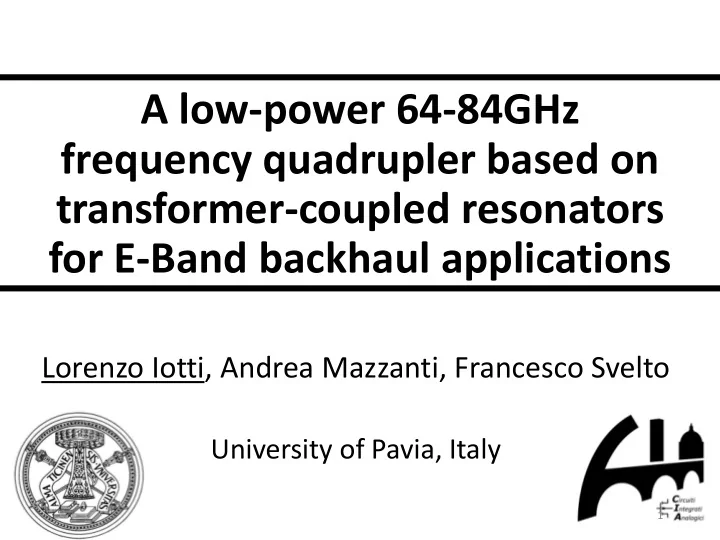

A low-power 64-84GHz frequency quadrupler based on transformer-coupled resonators for E-Band backhaul applications Lorenzo Iotti, Andrea Mazzanti, Francesco Svelto University of Pavia, Italy 1
Outline • E-Band wireless mobile backhaul • Frequency synthesizer architecture • BiCMOS frequency quadrupler design • Measurement results 2
Next-Generation Mobile Networks Massive growth in mobile traffic Massive growth in connected devices Cisco CCS 2013 Cisco VNI Mobile 2014 5G mobile networks have to meet further growth in mobile service channel capacity 3
E-Band Wireless Backhaul • Small cells require cheap, flexible, high-capacity, short- reach backhaul links • mm-Wave E-Band (71-76/81-86 GHz) allocated for wireless backhaul • High BTS density motivates CMOS/BiCMOS backhaul transceiver developement 4
Outline • E-Band wireless mobile backhaul • Frequency synthesizer architecture • BiCMOS frequency quadrupler design • Measurement results 5
Frequency Synthesizer Challenges • Wireless backhaul links employ high-order modulation (64QAM and beyond) to increase channel capacity • Integrated phase noise degrades EVM • Very severe phase noise requirements for CMOS mm- Wave circuits Modulation L(f) @ 1MHz Spec QPSK -90 dBc/Hz 16 QAM -96 dBc/Hz 64 QAM -102 dBc/Hz 6
Synthesizer Architecture • VCO exploits higher passive Q at 20 GHz for low phase noise • Wideband, low-power frequency quadrupler required 7
Outline • E-Band wireless mobile backhaul • Frequency synthesizer architecture • BiCMOS frequency quadrupler design • Measurement results 8
Frequency Doublers Push-push doubler Very simple Good efficiency No phase noise penalty Single ended output Limited GBW 9
Frequency Doublers Transformer-coupled push-push doubler XFMR used as balun for differential output IV order load improves GBW Low-k XFRM-coupled resonators provide wideband flat Z21 10
Capacitive Coupling in Balun • Common-mode current coupled to the output • Conversion gain drop • Lower II-harmonic rejection 11
Isolated Balun Simulated quadrupler performance • GND isolation through Normal Isolated bondwires provides high Balun Balun impedance for CM Av -9 dB -6 dB • Dummy coil recollects II-Harm Rej 15-25 dB 35 dB CM current 12
Transformer Layout 13
Frequency Quadrupler 40 GHz 80 GHz 20 GHz 16um/55nm 1um*0.4um • High-speed SiGe bipolars for better gain at 80 GHz • CMOS input stage for direct connection to high-swing VCO • Small capacitive banks compensate process mismatches 14
Outline • E-Band wireless mobile backhaul • Frequency synthesizer architecture • BiCMOS frequency quadrupler design • Measurement results 15
Test Chip • ST BiCMOS 55nm 220 um • Core area 0.08 mm 2 • Power 7mW 380 um • Vdd 1V/1.2V 16
Measurement Setup 17
Output Voltage 20GHz -3dB BW Vin = -4 dBV,diff,0pk 18
Amplitude Mismatch 19
Phase Noise 𝑄𝑂 𝑑𝑏𝑚𝑑 = 4𝑄𝑂 𝑗𝑜 + 𝑄𝑂 𝐸𝑝𝑥𝑜𝐷𝑝𝑜𝑤𝑓𝑠𝑡𝑗𝑝𝑜𝑈𝑝𝑜𝑓 20
Performance Summary This work Hung Mazzanti Wang Yeh RFIC 2015 ISSCC 2010 ISSCC 2012 RFIC 2015 Mult factor 4 2 2 4 4 Tech BiCMOS 55nm SOI 45nm CMOS 65nm SiGe 130nm SiGe 100nm Outputs Diff SE Diff SE SE Fout [GHz] 74 100 115 130 50 Fractional BW 27% 16% 13% 5% 24% Vdd [V] 1-1.2 3.6 1 1.6 3.3 Pdc [mW] 7 240 6 6.5 150 Gain [dB] -8 -5 0 0.6* 17 Aout,0pk 250 950 630 240* 800 Fund Harm 45 N/A N/A N/A 22 Rejection [dB] II Harmonic 35 N/A N/A N/A 22 Rejection [dB] Area [mm 2 ] 0.08 N/A 0.015 0.03 0.22 21 * Including 35mW input buffer
Conclusions • A 64-84GHz frequency quadrupler with 7mW power consumption was demonstrated in BiCMOS 55nm technology • It exploits transformer-coupled resonators in interstage and output matching networks for SE-to-differential conversion and GBW enhancement • CM isolation technique is employed in the baluns, leading to conversion gain and II-harmonic-rejection improvement • The multiplier is suitable as a building block in a low-phase- noise frequency synthesizer for E-Band backhaul links 22
Acknowledgement This work has been carried on in collaboration with STMicroelectronics, and has received funding from the European Union 7th Framework Programme (FP7/2007-2013) under grant agreement 619563 (MiWaveS). 23
Recommend
More recommend